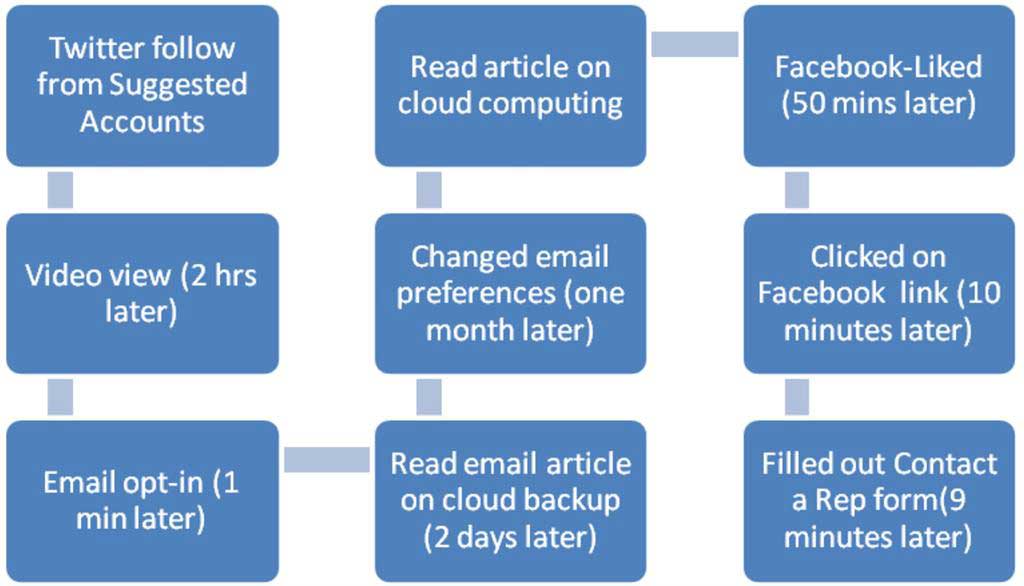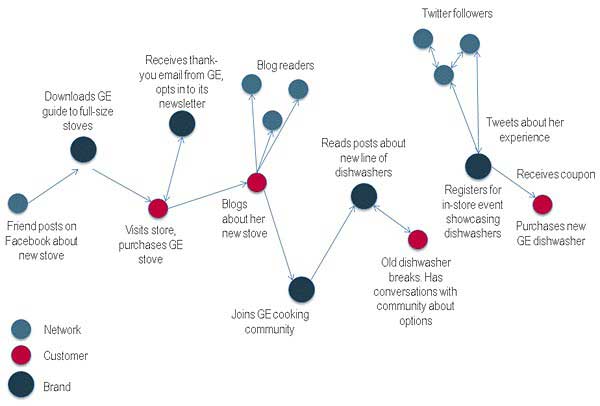Look beyond the hype of social media, and you'll see that social networks and community dynamics have fundamentally changed many of the most intrinsically understood truths of marketing communications. They have made marketing a much more complex process while creating a more measurable business practice.
This series of five articles will explore those changes (see list at the end of this article for previous and upcoming articles.)
One of those reassuring little white lies we tell ourselves as marketers is this: People make linear decisions. It's simpler to draw straight lines about people's behavior, so to date we have typically pushed people through carefully scripted marketing processes.
But does that really reflect people's actions and the ways they find information? Of course not. We all know it doesn't really happen that way.
But by rejecting that common fallacy we would face some more challenging questions: If we rigidly enforce our own processes, how many people do we leave behind? Can we trigger behavior, and if we can... which behaviors and how? How is the fragmenting media landscape changing the processes by which customers research and make purchases?
Traditional Marketing Approaches Fall Short in the New Customer Landscape
The answers are clear: Marketing has fundamentally changed, and many in the profession are struggling to catch up. The framework by which they understand marketing is not set up for a non-campaign world where they don't control timelines and control only experiences. The so-called sales funnel, if that was ever an accurate metaphor, no longer looks even remotely like a funnel.
Companies tend to view the sales and marketing process as a systematic approach of 7-9 steps that begins with initial contact and pushes the potential customer through sales lead, need identification, prospect qualification, and so on, through to closing the sale and then maintaining the customer relationship.
But that is how sales and marketing teams structure the selling process. The buying process, from the customer's perspective, is nothing like that.
How Buying Works in the Era of Social Media and Online Communities
Buying is a complex process with multiple stops, starts, and options. Each potential customer will move through the process in unique ways (although, in aggregate, demonstrating certain patterns of behavior). The movement is linear in that any two sales will end with the same result, but no two routes to that sale are exactly the same. The same is true for any type of engagement decision (e.g., joining an email list, following on Twitter).

The best marketers can hope to do in such an environment is to manage the process so that even though all roads may not lead to Rome, eventually all roads lead to, and through, digital "toll booths" of content and information exchange.
Why don't many marketing organizations view that process as a coherent customer narrative? Three reasons:
- Marketing is structured around campaigns, not customers.
- Marketers don't measure a linked sequence of customer actions across all touch points yet; they still think in terms of pre-sale and post-sale, not a relationship that can last a lifetime.
- Marketers have been determined to control the narrative rather than create digital touch points of content and experience, and then measure how people interact with those touch points.
How the New Customer Narrative Works
Whether they're interested in a new pair of shoes or a new virtual private network, future customers can first engage with a potential purchase in many ways. That engagement could be via a billboard with a URL that they type into their smartphone's mobile browser, or a click on a Facebook wall post from a friend's feed, or a search on Google.
Those are all examples of entry points to a research experience that could initiate a longer relationship between the customer and the brand; the relationship begins with the brand's getting permission to communicate more, and it progresses toward a sale and possibly many sales.
What happens between those start and end points is the complicated part, and the start and the end are almost never directly connected, especially when the activity begins with a discussion on social media or in an online community.
Consider an online relationship with a customer who makes two appliance purchases over four years, and twice shares content:

Today, those start and end points are not connected. By setting up measurement beacons that customers interact with, marketers can understand what each digital customer narrative looks like. And by shaping those experiences with content and the addition of community engagement, you can measure the context and experience of research and customer care from the first interaction and throughout the relationship. In that context, the true measure of influence is how many people take up your shared content.
If you have unlimited marketing budgets and don't care how they're spent, this approach might not matter to you. But it will matter if you're a results-driven marketer with limited resources who wants to really understand how each part of the marketing mix contributes to progression via either relationship or sales conversions—parallel but intersecting tracks that must both be viewed and measured to understand customer/buyer and audience dynamics.
That ties directly into small-movement marketing: By measuring how people progress through digital properties, we can see which marketing investments are performing and which are not.
* * *
In my next article, which will re-examine the sacred cows of marketing, I'll take a look at the role of content in measuring small-movement marketing and why it's not the message or—gasp!—even the copy that matters most anymore.
Articles in this series:
- The first article explored how the role of long-ball big-idea marketing is shifting amid the rise of "small-movement" marketing—how marketers are starting to shift away from trying to hit only home runs and are instead trying to foster deeper brand and relationship interactions online at the beginning of the customer relationship process.
- This article, the second in the series, discussed the death of the so-called funnel and the birth of the measurable customer narrative.
- The third article will focus on content versus messaging and what brands and marketers need to do with content to keep their customers' attention.
- The fourth article will look at the shifting role of brand management in the new, fragmented environment.
- This five-part series will conclude with an article focusing on the interplay between content and community and the role of community within the sales and marketing cycle.



